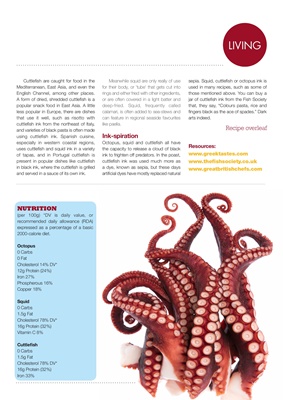
KITLIVING
NUTRITION
(per 100g) *DV is daily value, or
recommended daily allowance (RDA)
expressed as a percentage of a basic
2000-calorie diet.
Octopus
0 Carbs
0 Fat
Cholesterol 14% DV*
12g Protein (24%)
Iron 27%
Phospherous 16%
Copper 18%
Squid
0 Carbs
1.5g Fat
Cholesterol 78% DV*
16g Protein (32%)
Vitamin C 8%
Cuttlefish
0 Carbs
1.5g Fat
Cholesterol 78% DV*
16g Protein (32%)
Iron 33%
Cuttlefish are caught for food in the
Mediterranean, East Asia, and even the
English Channel, among other places.
A form of dried, shredded cuttlefish is a
popular snack food in East Asia. A little
less popular in Europe, there are dishes
that use it well, such as risotto with
cuttlefish ink from the northeast of Italy,
and varieties of black pasta is often made
using cuttlefish ink. Spanish cuisine,
especially in western coastal regions,
uses cuttlefish and squid ink in a variety
of tapas, and in Portugal cuttlefish is
present in popular dishes like cuttlefish
in black ink, where the cuttlefish is grilled
and served in a sauce of its own ink. Recipe overleaf
Meanwhile squid are only really of use
for their body, or 'tube' that gets cut into
rings and either fried with other ingredients,
or are often covered in a light batter and
deep-fried. Squid, frequently called
calamari, is often added to sea-stews and
can feature in regional seaside favourites
like paella.
Ink-spiration
Octopus, squid and cuttlefish all have the
capacity to release a cloud of black ink to
frighten off predators. Cuttlefish ink used
much more as a dye known as sepia,
but these days artificial dyes have mostly
replaced natural sepia. Squid, cuttlefish or
octopus ink is used in many recipes, such
as some of those mentioned above. You
can buy a jar of cuttlefish ink from the Fish
Society that, they say, "Colours pasta, rice
and fingers black as the ace of spades."
Resources
www.greektastes.com
www.thefishsociety.co.uk
www.greatbritishchefs.com